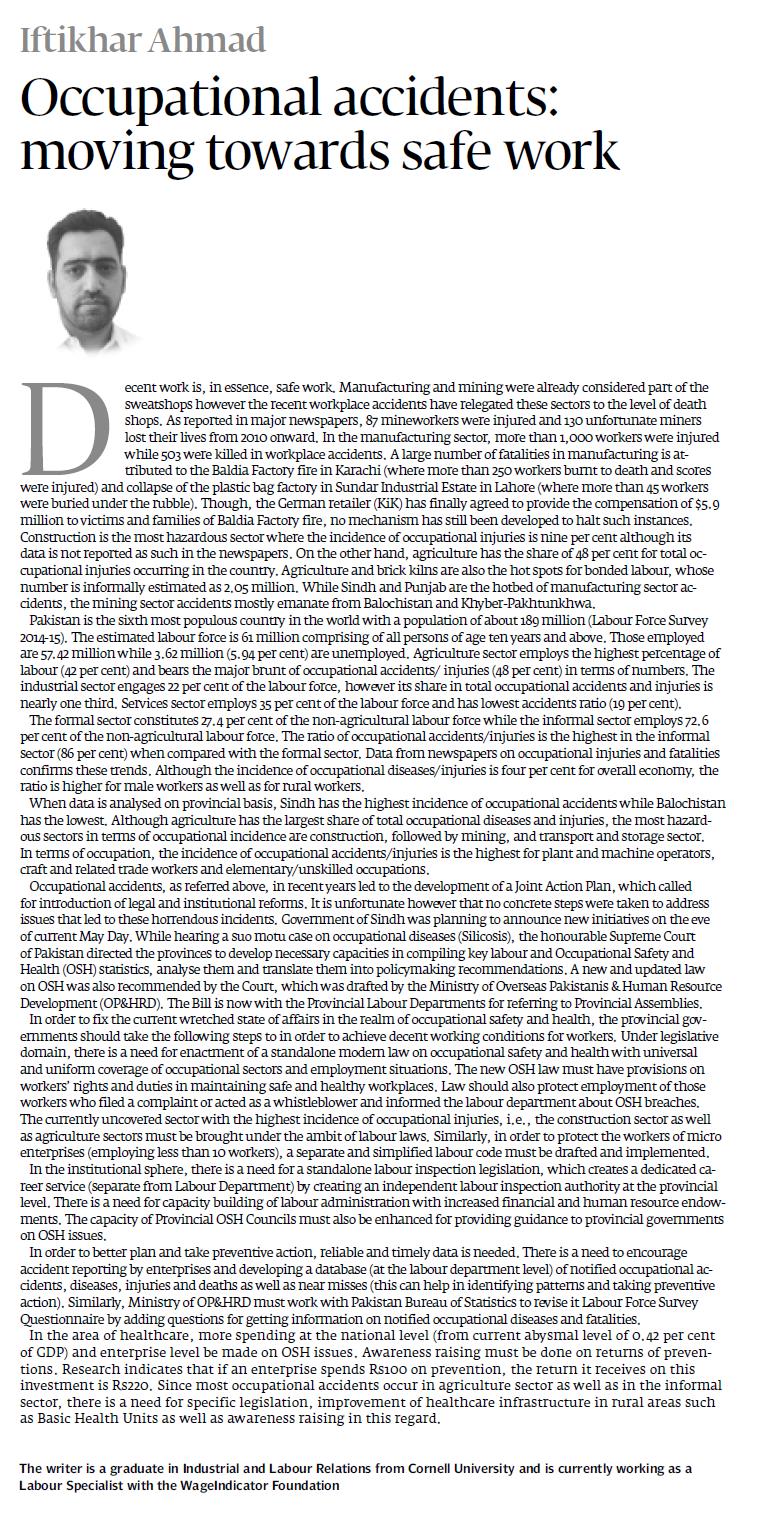
This article brings forward new data on occupational accidents and suggests reforms in legal and administrative regime which can help in decreasing the number of such incidents (examples are Bladia factory fire and Sundar Industrial Estate incidents as well as large number of deaths in mining sector).
Decent work is, in essence, safe work. Manufacturing and mining were already considered part of the sweatshops however the recent workplace accidents have relegated these sectors to the level of death shops. As reported in major newspapers, 87 mineworkers were injured and 130 unfortunate miners lost their lives from 2010 onward. In the manufacturing sector, more than 1,000 workers were injured while 503 were killed in workplace accidents. A large number of fatalities in manufacturing is attributed to the Baldia Factory fire in Karachi (where more than 250 workers burnt to death and scores were injured) and collapse of the plastic bag factory in Sundar Industrial Estate in Lahore (where more than 45 workers were buried under the rubble). Though, the German retailer (KiK) has finally agreed to provide the compensation of $5.9 million to victims and families of Baldia Factory fire, no mechanism has still been developed to halt such instances. Construction is the most hazardous sector where the incidence of occupational injuries is nine per cent although its data is not reported as such in the newspapers. On the other hand, agriculture has the share of 48 per cent for total occupational injuries occurring in the country. Agriculture and brick kilns are also the hot spots for bonded labour, whose number is informally estimated as 2.05 million. While Sindh and Punjab are the hotbed of manufacturing sector accidents, the mining sector accidents mostly emanate from Balochistan and Khyber-Pakhtunkhwa. Pakistan is the sixth most populous country in the world with a population of about 189 million (Labour Force Survey 2014-15). The estimated labour force is 61 million comprising of all persons of age ten years and above. Those employed are 57.42 million while 3.62 million (5.94 per cent) are unemployed. Agriculture sector employs the highest percentage of labour (42 per cent) and bears the major brunt of occupational accidents/ injuries (48 per cent) in terms of numbers. The industrial sector engages 22 per cent of the labour force, however its share in total occupational accidents and injuries is nearly one third. Services sector employs 35 per cent of the labour force and has lowest accidents ratio (19 per cent). The formal sector constitutes 27.4 per cent of the non-agricultural labour force while the informal sector employs 72.6 per cent of the non-agricultural labour force. The ratio of occupational accidents/injuries is the highest in the informal sector (86 per cent) when compared with the formal sector. Data from newspapers on occupational injuries and fatalities confirms these trends. Although the incidence of occupational diseases/injuries is four per cent for overall economy, the ratio is higher for male workers as well as for rural workers. When data is analysed on provincial basis, Sindh has the highest incidence of occupational accidents while Balochistan has the lowest. Although agriculture has the largest share of total occupational diseases and injuries, the most hazardous sectors in terms of occupational incidence are construction, followed by mining, and transport and storage sector. In terms of occupation, the incidence of occupational accidents/injuries is the highest for plant and machine operators, craft and related trade workers and elementary/unskilled occupations. Occupational accidents, as referred above, in recent years led to the development of a Joint Action Plan, which called for introduction of legal and institutional reforms. It is unfortunate however that no concrete steps were taken to address issues that led to these horrendous incidents. Government of Sindh was planning to announce new initiatives on the eve of current May Day. While hearing a suo motu case on occupational diseases (Silicosis), the honourable Supreme Court of Pakistan directed the provinces to develop necessary capacities in compiling key labour and Occupational Safety and Health (OSH) statistics, analyse them and translate them into policymaking recommendations. A new and updated law on OSH was also recommended by the Court, which was drafted by the Ministry of Overseas Pakistanis & Human Resource Development (OP&HRD). The Bill is now with the Provincial Labour Departments for referring to Provincial Assemblies. In order to fix the current wretched state of affairs in the realm of occupational safety and health, the provincial governments should take the following steps to in order to achieve decent working conditions for workers. Under legislative domain, there is a need for enactment of a standalone modern law on occupational safety and health with universal and uniform coverage of occupational sectors and employment situations. The new OSH law must have provisions on workers’ rights and duties in maintaining safe and healthy workplaces. Law should also protect employment of those workers who filed a complaint or acted as a whistleblower and informed the labour department about OSH breaches. The currently uncovered sector with the highest incidence of occupational injuries, i.e., the construction sector as well as agriculture sectors must be brought under the ambit of labour laws. Similarly, in order to protect the workers of micro enterprises (employing less than 10 workers), a separate and simplified labour code must be drafted and implemented. In the institutional sphere, there is a need for a standalone labour inspection legislation, which creates a dedicated career service (separate from Labour Department) by creating an independent labour inspection authority at the provincial level. There is a need for capacity building of labour administration with increased financial and human resource endowments. The capacity of Provincial OSH Councils must also be enhanced for providing guidance to provincial governments on OSH issues. In order to better plan and take preventive action, reliable and timely data is needed. There is a need to encourage accident reporting by enterprises and developing a database (at the labour department level) of notified occupational accidents, diseases, injuries and deaths as well as near misses (this can help in identifying patterns and taking preventive action). Similarly, Ministry of OP&HRD must work with Pakistan Bureau of Statistics to revise it Labour Force Survey Questionnaire by adding questions for getting information on notified occupational diseases and fatalities. In the area of healthcare, more spending at the national level (from current abysmal level of 0.42 per cent of GDP) and enterprise level be made on OSH issues. Awareness raising must be done on returns of preventions. Research indicates that if an enterprise spends Rs100 on prevention, the return it receives on this investment is Rs220. Since most occupational accidents occur in agriculture sector as well as in the informal sector, there is a need for specific legislation, improvement of healthcare infrastructure in rural areas such as Basic Health Units as well as awareness raising in this regard. The article was published on 4 November 2016 by the ExpressTribune.
Decent work is, in essence, safe work. Manufacturing and mining were already considered part of the sweatshops however the recent workplace accidents have relegated these sectors to the level of death shops. As reported in major newspapers, 87 mineworkers were injured and 130 unfortunate miners lost their lives from 2010 onward. In the manufacturing sector, more than 1,000 workers were injured while 503 were killed in workplace accidents. A large number of fatalities in manufacturing is attributed to the Baldia Factory fire in Karachi (where more than 250 workers burnt to death and scores were injured) and collapse of the plastic bag factory in Sundar Industrial Estate in Lahore (where more than 45 workers were buried under the rubble). Though, the German retailer (KiK) has finally agreed to provide the compensation of $5.9 million to victims and families of Baldia Factory fire, no mechanism has still been developed to halt such instances. Construction is the most hazardous sector where the incidence of occupational injuries is nine per cent although its data is not reported as such in the newspapers. On the other hand, agriculture has the share of 48 per cent for total occupational injuries occurring in the country. Agriculture and brick kilns are also the hot spots for bonded labour, whose number is informally estimated as 2.05 million. While Sindh and Punjab are the hotbed of manufacturing sector accidents, the mining sector accidents mostly emanate from Balochistan and Khyber-Pakhtunkhwa. Pakistan is the sixth most populous country in the world with a population of about 189 million (Labour Force Survey 2014-15). The estimated labour force is 61 million comprising of all persons of age ten years and above. Those employed are 57.42 million while 3.62 million (5.94 per cent) are unemployed. Agriculture sector employs the highest percentage of labour (42 per cent) and bears the major brunt of occupational accidents/ injuries (48 per cent) in terms of numbers. The industrial sector engages 22 per cent of the labour force, however its share in total occupational accidents and injuries is nearly one third. Services sector employs 35 per cent of the labour force and has lowest accidents ratio (19 per cent). The formal sector constitutes 27.4 per cent of the non-agricultural labour force while the informal sector employs 72.6 per cent of the non-agricultural labour force. The ratio of occupational accidents/injuries is the highest in the informal sector (86 per cent) when compared with the formal sector. Data from newspapers on occupational injuries and fatalities confirms these trends. Although the incidence of occupational diseases/injuries is four per cent for overall economy, the ratio is higher for male workers as well as for rural workers. When data is analysed on provincial basis, Sindh has the highest incidence of occupational accidents while Balochistan has the lowest. Although agriculture has the largest share of total occupational diseases and injuries, the most hazardous sectors in terms of occupational incidence are construction, followed by mining, and transport and storage sector. In terms of occupation, the incidence of occupational accidents/injuries is the highest for plant and machine operators, craft and related trade workers and elementary/unskilled occupations. Occupational accidents, as referred above, in recent years led to the development of a Joint Action Plan, which called for introduction of legal and institutional reforms. It is unfortunate however that no concrete steps were taken to address issues that led to these horrendous incidents. Government of Sindh was planning to announce new initiatives on the eve of current May Day. While hearing a suo motu case on occupational diseases (Silicosis), the honourable Supreme Court of Pakistan directed the provinces to develop necessary capacities in compiling key labour and Occupational Safety and Health (OSH) statistics, analyse them and translate them into policymaking recommendations. A new and updated law on OSH was also recommended by the Court, which was drafted by the Ministry of Overseas Pakistanis & Human Resource Development (OP&HRD). The Bill is now with the Provincial Labour Departments for referring to Provincial Assemblies. In order to fix the current wretched state of affairs in the realm of occupational safety and health, the provincial governments should take the following steps to in order to achieve decent working conditions for workers. Under legislative domain, there is a need for enactment of a standalone modern law on occupational safety and health with universal and uniform coverage of occupational sectors and employment situations. The new OSH law must have provisions on workers’ rights and duties in maintaining safe and healthy workplaces. Law should also protect employment of those workers who filed a complaint or acted as a whistleblower and informed the labour department about OSH breaches. The currently uncovered sector with the highest incidence of occupational injuries, i.e., the construction sector as well as agriculture sectors must be brought under the ambit of labour laws. Similarly, in order to protect the workers of micro enterprises (employing less than 10 workers), a separate and simplified labour code must be drafted and implemented. In the institutional sphere, there is a need for a standalone labour inspection legislation, which creates a dedicated career service (separate from Labour Department) by creating an independent labour inspection authority at the provincial level. There is a need for capacity building of labour administration with increased financial and human resource endowments. The capacity of Provincial OSH Councils must also be enhanced for providing guidance to provincial governments on OSH issues. In order to better plan and take preventive action, reliable and timely data is needed. There is a need to encourage accident reporting by enterprises and developing a database (at the labour department level) of notified occupational accidents, diseases, injuries and deaths as well as near misses (this can help in identifying patterns and taking preventive action). Similarly, Ministry of OP&HRD must work with Pakistan Bureau of Statistics to revise it Labour Force Survey Questionnaire by adding questions for getting information on notified occupational diseases and fatalities. In the area of healthcare, more spending at the national level (from current abysmal level of 0.42 per cent of GDP) and enterprise level be made on OSH issues. Awareness raising must be done on returns of preventions. Research indicates that if an enterprise spends Rs100 on prevention, the return it receives on this investment is Rs220. Since most occupational accidents occur in agriculture sector as well as in the informal sector, there is a need for specific legislation, improvement of healthcare infrastructure in rural areas such as Basic Health Units as well as awareness raising in this regard. The article was published on 4 November 2016 by the ExpressTribune.


